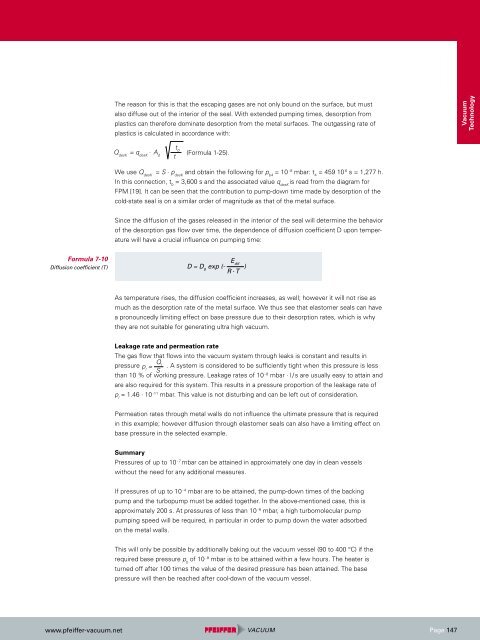You also want an ePaper? Increase the reach of your titles
YUMPU automatically turns print PDFs into web optimized ePapers that Google loves.
Formula 7-10<br />
Diffusion coefficient (T)<br />
www.pfeiffer-vacuum.net<br />
The reason for this is that the escaping gases are not only bound on the surface, but must<br />
also diffuse out of the interior of the seal. With extended pumping times, desorption from<br />
plastics can therefore dominate desorption from the metal surfaces. The outgassing rate of<br />
plastics is calculated in accordance with:<br />
Q desK = q desK . Ad<br />
t<br />
t 0<br />
(Formula 1-25).<br />
We use Q desK = S . p desK and obtain the following for p b4 = 10 - 8 mbar: t 4 = 459 10 6 s = 1,277 h.<br />
In this connection, t 0 = 3,600 s and the associated value q desK is read from the diagram for<br />
FPM [19]. It can be seen that the contribution to pump-down time made by desorption of the<br />
cold-state seal is on a similar order of magnitude as that of the metal surface.<br />
Since the diffusion of the gases released in the interior of the seal will determine the behavior<br />
of the desorption gas flow over time, the dependence of diffusion coefficient D upon temperature<br />
will have a crucial influence on pumping time:<br />
E dif<br />
D = D 0 exp (- )<br />
R . T<br />
As temperature rises, the diffusion coefficient increases, as well; however it will not rise as<br />
much as the desorption rate of the metal surface. We thus see that elastomer seals can have<br />
a pronouncedly limiting effect on base pressure due to their desorption rates, which is why<br />
they are not suitable for generating ultra high vacuum.<br />
Leakage rate and permeation rate<br />
The gas flow that flows into the vacuum system through leaks is constant and results in<br />
pressure . A system is considered to be sufficiently tight when this pressure is less<br />
than 10 % of working pressure. Leakage rates of 10 - 8 mbar . Ql p = l S<br />
l / s are usually easy to attain and<br />
are also required for this system. This results in a pressure proportion of the leakage rate of<br />
p l = 1.46 . 10 -11 mbar. This value is not disturbing and can be left out of consideration.<br />
Permeation rates through metal walls do not influence the ultimate pressure that is required<br />
in this example; however diffusion through elastomer seals can also have a limiting effect on<br />
base pressure in the selected example.<br />
Summary<br />
Pressures of up to 10 - 7 mbar can be attained in approximately one day in clean vessels<br />
without the need for any additional measures.<br />
If pressures of up to 10 - 4 mbar are to be attained, the pump-down times of the backing<br />
pump and the turbopump must be added together. In the above-mentioned case, this is<br />
approximately 200 s. At pressures of less than 10 - 6 mbar, a high turbomolecular pump<br />
pumping speed will be required, in particular in order to pump down the water adsorbed<br />
on the metal walls.<br />
This will only be possible by additionally baking out the vacuum vessel (90 to 400 °C) if the<br />
required base pressure p b of 10 - 8 mbar is to be attained within a few hours. The heater is<br />
turned off after 100 times the value of the desired pressure has been attained. The base<br />
pressure will then be reached after cool-down of the vacuum vessel.<br />
Page 147<br />
<strong>Vacuum</strong><br />
<strong>Technology</strong>

















